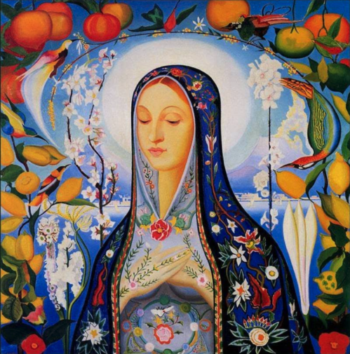This year we are focusing our Mercy Moments on Ancient and Indigenous wisdom and this week is the turn of Hildegard of Bingen (1098 –1179), a German Benedictine abbess, writer, poet, composer, philosopher, mystic, dreamer, visionary, leader, scientist and mathematician of her time. In a world before instant communication and mass media, aeroplanes or cars, the printing press or university education, she was a superstar – renowned for her wisdom, advisor to Popes, consultant to kings and emperors and a greatly sought after speaker and teacher.

So, what can we learn from Hildegard of Bingen today? In his book Christian Mystics, Matthew Fox notes that ‘The crises we find ourselves in as a species require that we shake up all of our institutions – including our religious ones – and reinvent them’ (2011. P.2). This is exactly what Hildegard did. She shook up her world’s understanding of theology and creation – challenging those she taught to consider the power of connectedness, the nature of Divine love and the capacity we all have within us to make a difference in our world, to see and imagine a better way.
The earth is at the same time mother, she is mother of all that is natural, mother of all that is human. She is mother of all, for contained in her are the seeds of all.
Here, Hildegard’s words resonate strongly with contemporary creation spirituality and the living legacy of indigenous people around the world who reverence the earth as mother. Hildegard strongly challenged the prevailing ideas of her time – the pre-Copernican view of the ordered universe controlled by a remote God.
When Hildegard writes: ‘Holy Spirit, you are the mighty way in which everything that is in the heavens, on the earth, and under the earth, is penetrated with connectedness, is penetrated with relatedness’, she again espouses a view of creation celebrated by indigenous wisdom – the Celts, the North American Indigenous peoples and Australia’s Aboriginal people all regarded interdependence and interrelatedness of all life as central to life.
For Hildegard creation is light and there is light in everything that exists: There is no creation that does not have radiance. Be it greenness or seed, blossom or beauty. It would not be creation without it. She challenges us to see Divine radiance in everyone and everything in our created world. Hildegard aligns with most mystics who regard life as God essence.
This article cannot do justice to the many facets of the wisdom of Hildegard of Bingen, but just these few lines demonstrate the depth of her understanding of Divine presence and the creative energy which swirls within us all. Hildegard certainly shook up her listeners, steeped as they were in religious dogma, Church power and the theology of sin and redemption.
Fox suggests that ‘Deep down, each one of us is a mystic. When we tap into that energy we become alive again and we give birth. From the creativity that we release is born the prophetic vision and work that we all aspire to realise as our gift to the world… getting in touch with the mystic inside is the beginning of our deep service’ (Fox. M. Christian Mystics. 2011. P.3).
Our Christian tradition is starting to regain its mystics and their teaching; the great thinkers who ventured beyond the accepted answers and uncovered the power of God’s great love. As Hildegard reminds us: As the Creator loves creation, so creation loves the creator. Creation, of course, was fashioned to be adorned, to be showered, to be gifted with the love of the creator. The entire world had been embraced by this kiss.
We have much to learn from Hildegard of Bingen.
Reflection
How can we get in touch with the mystic inside in order to realise our gift to the world?
